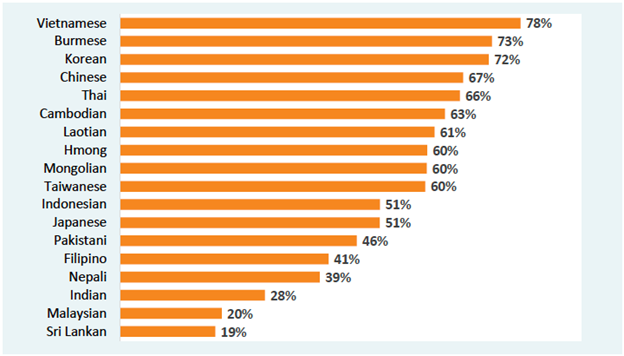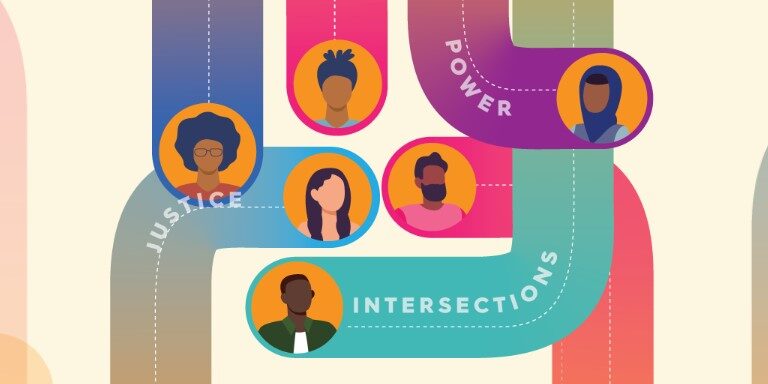
August 2024
By Thai V. Le, Shannon Camacho, Chuchen Pan, Alicia Vo
As the fastest-growing racial/ethnic group in the United States, largely contributed by increasing migration from Asia, Asian Americans are estimated to be the largest immigrant group in the country by 2055. The growing and increasingly diverse population contributes to an expanding interest and need to understand the nuanced experiences of Asian American immigrants, including their pathways to citizenship. Given the existing citizenship regime in the United States, naturalization is an essential process for immigrants and their social, economic, and political inclusion. The benefits of naturalization include the right to vote, improved potential to sponsor family members, expanded eligibility for social services, and access to jobs that require citizenship. Though the benefits of naturalizing are multifold for immigrants and their inclusion, improving access to naturalization also facilitates a more representative and democratic society. In this report, we take a mixed-methods approach to explore the drivers and barriers to naturalization. Our report dives into the nuanced pathways to citizenship for Asian American immigrants, using statistical modeling, surveys, and interviews to tease out the differences in experience due to ethnicity, migration history, socioeconomic status, gender, age, and more.
We further examine the role community-based organizations play in supporting immigrants and their pathways to citizenship, which is often a costly and intricate process. Research concerning the challenges and opportunities in serving Asian American immigrants, especially with consideration of the community’s vast diversity, is limited. Our research begins to address this gap through a qualitative analysis of organizations’ experiences serving Asian American immigrants throughout California. In our open-ended survey and interviews, organizations shared numerous barriers and challenges their Asian American immigrant clients face in accessing social services and undergoing the naturalization process. Furthermore, organizations discussed their own difficulties with addressing these barriers. We provide recommendations for organizations and advocacy groups, funders, and policymakers and local government entities to support the naturalization process for Asian American immigrants, facilitating their social, economic, and political inclusion in the United States.
A Highlight from the Report:
Our statistical analysis shows that English proficiency is a strong predictor of naturalization across Asian American immigrant groups. Many organizations shared that Asian American immigrant clients’ lack of English proficiency often deterred them from attempting to naturalize, due to the difficulty of the required English and civics exam:
“It’s not that they don’t want to stay [in the U.S.], but because the process [of naturalization] is too complicated. I know some clients – they don’t know English that well and they are very unfamiliar with the application process and the N-400 preparation. So, when it comes to applying for citizenship, like the interview, they can’t do that and because of that, they have no interest anymore.”
English proficiency is a significant barrier across immigrant groups and their pathways to citizenship. It is important to note that the rate of English proficiency varies within the Asian American immigrant community. Among eligible-to-naturalize Asian American immigrants in California, Sri Lankan immigrants are the least likely and Vietnamese immigrants are the most likely to report limited English proficiency.
SHARE OF ELIGIBLE-TO-NATURALIZE ASIAN AMERICAN IMMIGRANTS WITH LIMITED ENGLISH PROFICIENCY BY ANCESTRY, CALIFORNIA, 2017-2021

Source: USC Equity Research Institute analysis of 2021 5-year American Community Survey microdata from IPUMS USA. Note: Universe includes foreign-born residents eligible to naturalize. For detailed description of how the eligible-to-naturalize population is estimated, see: https://dornsife.usc.edu/eri/wp-content/uploads/sites/41/2023/10/Estimating_Immigrants_by_Status_in_the_ACS_Microdata.pdf. Immigrants are considered having limited English proficiency if they report speaking English less than “very well.” Data represents 2017 to 2021 averages.
Though resources and services are available to help immigrants pass the English and civics exam, they are not equitably accessible given other barriers they may face:
“I’ve had a lot of clients who prepared the naturalization application, but they cannot pass their English language and civics exam and they had to go in multiple times, still do not pass. And this is a real barrier, I think, especially for folks who live in ethnic enclaves that work full time. And I always try to recommend that they do go study ESL or find ways to improve, but there’s just no time. These are people that work seven days a week and there’s no options. They want to make money so that they can raise their kids and then their kids can do those things.”
To improve access to these important resources, funders can fund English and citizenship classes across the state, available to all immigrants and made known to immigrant-serving organizations. In particular, funders can assess where there are the greatest needs for English and citizenship classes considering geographical and time constraints immigrants experience. As we heard from organizations serving Asian American immigrants, immigrants may forgo free or low-cost English classes when they are not accessible because of transportation barriers or because they are not offered at convenient times outside of working hours.
Importantly, organizations also shared how low-income immigrant clients struggling to make ends meet do not have the “luxury” to take English language and citizenship classes because they are working around the clock. To address this, funders should work with organizations to compensate immigrants for their language-learning time through monetary stipends, scholarships, or temporary economic relief. Such incentives may reduce the financial barriers immigrants face and encourage participation in English language and citizenship classes. Such monetary incentives have been adopted by other countries to encourage language acquisition among newly-arrived immigrants.



